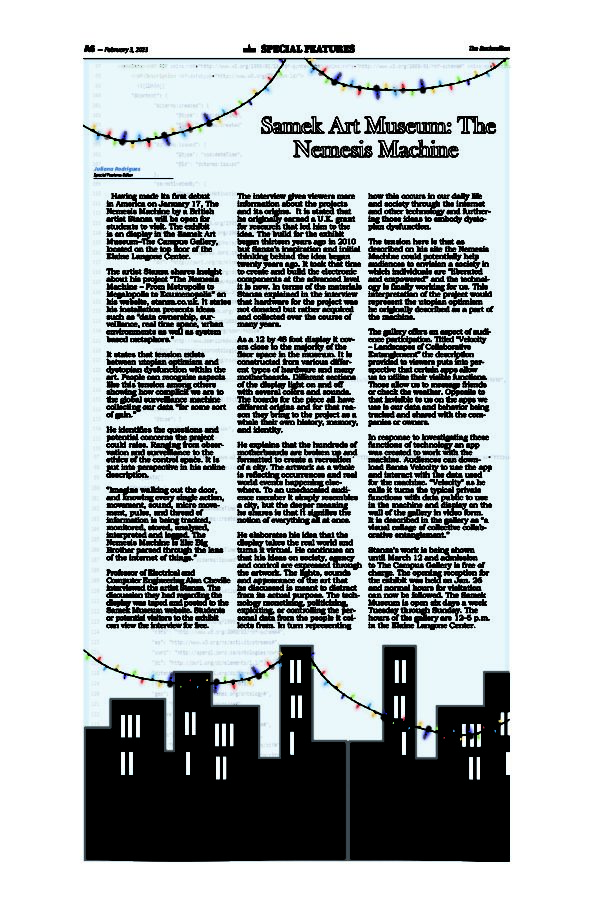Samek Art Museum: The Nemesis Machine
February 3, 2023
Having made its first debut in America on January 17, The Nemesis Machine by a British artist Stanza will be open for students to visit. The exhibit is on display in the Samek Art Museum–The Campus Gallery, located on the top floor of the Elaine Langone Center.
The artist Stanza shares insight about his project “The Nemesis Machine – From Metropolis to Megalopolis to Ecumenopolis” on his website, stanza.co.uk. It states his installation presents ideas such as “data ownership, surveillance, real time space, urban environments as well as system based metaphors.”
It states that tension exists between utopian optimism and dystopian dysfunction within the art. People can recognize aspects like this tension among others showing how complicit we are to the global surveillance machine collecting our data “for some sort of gain.”
He identifies the questions and potential concerns the project could raise. Ranging from observation and surveillance to the ethics of the control space. It is put into perspective in his online description.
“Imagine walking out the door, and knowing every single action, movement, sound, micro movement, pulse, and thread of information is being tracked, monitored, stored, analyzed, interpreted and logged. The Nemesis Machine is like Big Brother parsed through the lens of the internet of things.”
Professor of Electrical and Computer Engineering Alan Cheville interviewed the artist Stanza. The discussion they had regarding the display was taped and posted to the Samek Museum website. Students or potential visitors to the exhibit can view the interview for free.
The interview gives viewers more information about the projects and its origins. It is stated that he originally earned a U.K. grant for research that led him to the idea. The build for the exhibit began thirteen years ago in 2010 but Sanza’s inspiration and initial thinking behind the idea began twenty years ago. It took that time to create and build the electronic components at the advanced level it is now. In terms of the materials Stanza explained in the interview that hardware for the project was not donated but rather acquired and collected over the course of many years.
As a 12 by 48 foot display it covers close to the majority of the floor space in the museum. It is constructed from various different types of hardware and many motherboards. Different sections of the display light on and off with several colors and sounds. The boards for the piece all have different origins and for that reason they bring to the project as a whole their own history, memory, and identity.
He explains that the hundreds of motherboards are broken up and formatted to create a recreation of a city. The artwork as a whole is reflecting occurrences and real world events happening elsewhere. To an uneducated audience member it simply resembles a city, but the deeper meaning he shares is that it signifies the notion of everything all at once.
He elaborates his idea that the display takes the real world and turns it virtual. He continues on that his ideas on society, agency and control are expressed through the artwork. The lights, sounds and appearance of the art that he discussed is meant to distract from its actual purpose. The technology monetizing, politicizing, exploiting, or controlling the personal data from the people it collects from. In turn representing how this occurs in our daily life and society through the internet and other technology and furthering those ideas to embody dystopian dysfunction.
The tension here is that as described on his site the Nemesis Machine could potentially help audiences to envision a society in which individuals are “liberated and empowered” and the technology is finally working for us. This interpretation of the project would represent the utopian optimism he originally described as a part of the machine.
The gallery offers an aspect of audience participation. Titled “Velocity – Landscapes of Collaborative Entanglement” the description provided to viewers puts into perspective that certain apps allow us to utilize their visible functions. Those allow us to message friends or check the weather. Opposite to that invisible to us on the apps we use is our data and behavior being tracked and shared with the companies or owners.
In response to investigating these functions of technology an app was created to work with the machine. Audiences can download Sanza Velocity to use the app and interact with the data used for the machine. “Velocity” as he calls it turns the typical private functions with data public to use in the machine and display on the wall of the gallery in video form. It is described in the gallery as “a visual collage of collective collaborative entanglement.”
Stanza’s work is being shown until March 12 and admission to The Campus Gallery is free of charge. The opening reception for the exhibit was held on Jan. 26 and normal hours for visitation can now be followed. The Samek Museum is open six days a week Tuesday through Sunday. The hours of the gallery are 12–5 p.m. in the Elaine Langone Center.





















